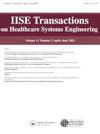Image decomposition-based sparse extreme pixel-level feature detection model with application to medical images
IF 1.5
Q3 HEALTH CARE SCIENCES & SERVICES
IISE Transactions on Healthcare Systems Engineering
Pub Date : 2021-04-07
DOI:10.1080/24725579.2021.1910599
引用次数: 2
Abstract
Abstract Pixel-level feature detection from images is an essential but challenging task encountered in domains such as detecting defects in manufacturing systems and detecting tumors in medical imaging. Often, the real image contains multiple feature types. The types with higher pixel intensities are termed as positive (extreme) features and the ones with lower pixel intensities as negative (extreme) features. For example, when planning a medical treatment, it is important to identify, (a) calcification (a pathological feature which can result in a post-surgical complications) as positive features, and (b) soft tissues (organ morphology, knowledge of which can support pre-surgical planning) as negative features, from a preoperative computed tomography image of the human heart. However, this is not an easy task because (a) conventional segmentation techniques require manual intervention and post-processing, and (b) existing automatic approaches do not distinguish positive features from negative. In this work, we propose a novel, automatic image decomposition-based sparse extreme pixel-level feature detection model to decompose an image into mean and extreme features. To estimate model parameters, a high-dimensional least squares regression with regularization and constraints is utilized. An efficient algorithm based on the alternating direction method of multipliers and the proximal gradient method is developed to solve the large-scale optimization problem. The effectiveness of the proposed model is demonstrated using synthetic tests and a real-world case study, where the model exhibits superior performance over existing methods.基于图像分解的稀疏极值像素级特征检测模型及其在医学图像中的应用
摘要从图像中进行像素级特征检测是在制造系统中检测缺陷和医学成像中检测肿瘤等领域中遇到的一项重要但具有挑战性的任务。通常,真实图像包含多种特征类型。具有较高像素强度的类型被称为正(极端)特征,具有较低像素强度的类别被称为负(极端)特性。例如,在计划医疗时,重要的是从人类心脏的术前计算机断层扫描图像中识别(a)钙化(可能导致术后并发症的病理特征)为阳性特征,以及(b)软组织(器官形态,其知识可以支持术前计划)为阴性特征。然而,这不是一项容易的任务,因为(a)传统的分割技术需要手动干预和后处理,以及(b)现有的自动方法不能区分积极特征和消极特征。在这项工作中,我们提出了一种新的基于图像自动分解的稀疏极端像素级特征检测模型,将图像分解为均值和极值特征。为了估计模型参数,使用了具有正则化和约束的高维最小二乘回归。针对大规模优化问题,提出了一种基于乘法器交替方向法和近似梯度法的高效算法。使用合成测试和真实世界的案例研究证明了所提出的模型的有效性,其中该模型表现出优于现有方法的性能。
本文章由计算机程序翻译,如有差异,请以英文原文为准。
求助全文
约1分钟内获得全文
求助全文
来源期刊

IISE Transactions on Healthcare Systems Engineering
Social Sciences-Safety Research
CiteScore
3.10
自引率
0.00%
发文量
19
期刊介绍:
IISE Transactions on Healthcare Systems Engineering aims to foster the healthcare systems community by publishing high quality papers that have a strong methodological focus and direct applicability to healthcare systems. Published quarterly, the journal supports research that explores: · Healthcare Operations Management · Medical Decision Making · Socio-Technical Systems Analysis related to healthcare · Quality Engineering · Healthcare Informatics · Healthcare Policy We are looking forward to accepting submissions that document the development and use of industrial and systems engineering tools and techniques including: · Healthcare operations research · Healthcare statistics · Healthcare information systems · Healthcare work measurement · Human factors/ergonomics applied to healthcare systems Research that explores the integration of these tools and techniques with those from other engineering and medical disciplines are also featured. We encourage the submission of clinical notes, or practice notes, to show the impact of contributions that will be published. We also encourage authors to collect an impact statement from their clinical partners to show the impact of research in the clinical practices.
 求助内容:
求助内容: 应助结果提醒方式:
应助结果提醒方式:


